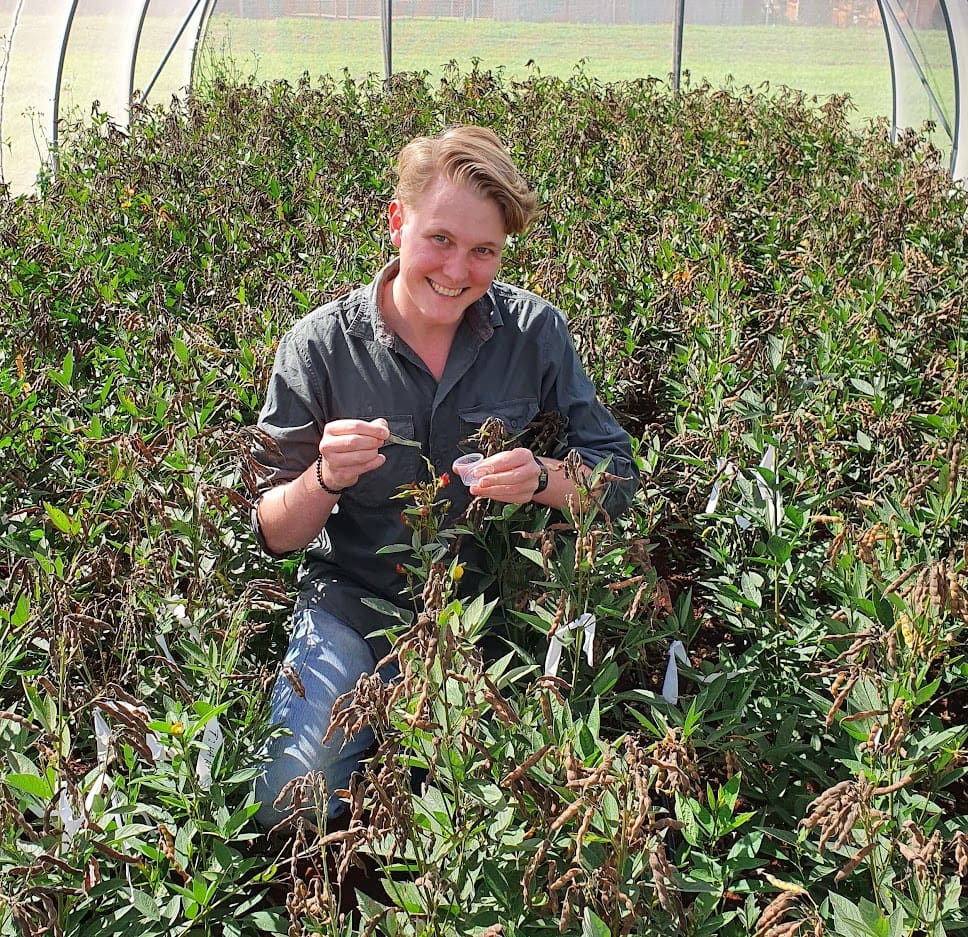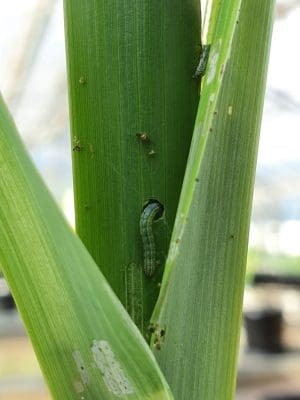
Entomologist Trevor Volp at work. Photo: QDAF
THE DOUBLE life of the fall armyworm (FAW) could be disguising its preferred home, according to new Queensland research.
The scientists report that plants previously thought to host the cropping pest might not serve that role through the insect’s whole life cycle.
The research, a collaboration between Queensland’s Department of Agriculture and Fisheries (QDAF) and the University of Queensland, has helped differentiate between plants FAW prefers as secondary food sources with those where populations are generated.
Maize preferred
Lead scientist Trevor Volp, an entomologist at QDAF, said the study revealed maize as FAW’s preferred host plant.
“There is a large body of literature reporting that many crop species are at risk from FAW, but since the pest’s incursion into Australia, maize, sweet corn, and sorghum have experienced most of the damage,” Mr Volp said.

A fall armyworm chews through a maize leaf. Photo: QDAF
According to Plant Health Australia, fall armyworm, or Spodoptera frugiperda, is a moth pest that feeds in large numbers on the leaves, stems and reproductive parts of more than 350 plant species.
This causes major damage to economically important cultivated grasses such as maize, rice, sorghum, sugarcane and wheat and also vegetable crops and cotton.
A native to the North and South Americas, FAW was first reported in Australia in January 2020 in the Torres Strait and by the end of the year had spread to New South Wales and northern Victoria.
In this time, it has caused significant damage to production industries, in particular maize, popcorn, and sweetcorn, but impacts to other crops such as sorghum, as well as pastures have also been observed.
It is resistant to most of the older chemical pesticides and is proving very difficult to manage, resulting in crop failures.
Hard to control
Newer chemicals are expensive and only work well with good spray coverage and timing.
“Many of the reported host plant records consist of a caterpillar being collected from a plant, and that plant is then recorded as a ‘host.’
“These records from overseas provide little detail about whether the plant species is preferred by the moth or if caterpillar infestations can actually establish well on the plant.
“Understanding these details are incredibly important if the plant species is a crop, because they determine whether the crop is at risk from yield loss due to the pest.”
The researchers believe FAW have two feeding modes.
“Firstly there is the ‘defoliator’ mode, where the moth lay eggs on a crop and the larvae hatch, feed, and develop on the plant.
“Secondly there’s an ‘armyworm’ mode, where the moth lays eggs on grasses and then large caterpillars switch to feeding on other crops.
“Many of the plant species listed as host plants are damaged in this second mode but might not host populations through the insect’s whole life cycle.
“Therefore, they are not truly host plants.
“We have seen numerous cases of this in Australia now – populations establishing on corn or sorghum, then crawling to infest a nearby broadleaf crop.”
To investigate host preference, the team performed experiments on moth egg-laying and caterpillar-feeding behaviour on maize, sorghum, peanut, cotton and pigeon pea.
In the egg-laying experiment, they found that FAW laid significantly more eggs on glasshouse-grown maize than on any of the other four crops.
They also attached egg masses to the plants in the glasshouse and studied development of the caterpillars.
After five days there were most survivors on maize and the least on cotton.
Sorghum hosted the most pupated caterpillars, cotton the least.
Host, food plants differ
The results have led the team to suggest that maize and sorghum are host plants, whereas pigeon pea, peanut, and cotton are food plants.
“It is important to examine the preference of moths and the behaviour of caterpillars using whole plants. This method allows us to judge what plant species are really at risk to adequately prepare farmers for when new pests arrive.”
Other researchers working on the trial were Dr Myron Zalucki and Dr Michael Furlong.
Grain Central: Get our free news straight to your inbox – Click here

Why is there no research being undertaken on the use of releasing sterile males to break the breeding cycle. Is it because it offers no IP $ returns.
I seem to be missing something here. Doesn’t this confirm what is already known?